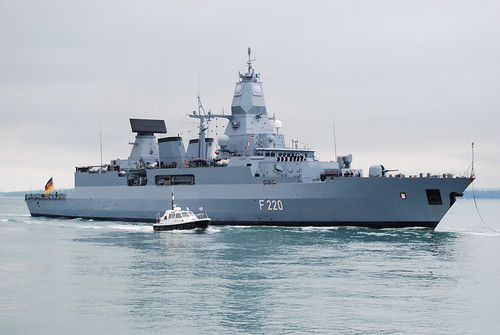เรือฮัมเบิร์กเป็นเรือฟริเกตที่มีสรรมถนะในการรบทั้งแบบพื้นสู่อากาศและต่อต้านขีปนาวุธโจมตีเรือ
และเป็นเรือแบบเดียวของโลกตะวันตกที่ติดตั้งอาวุธต่อต้านขีปนาวุธทางอากาศ 3 แบบ คือ
- the Standard Missile 2 block IIIA (SM-2)
- the Evolved Sea Sparrow Missile (ESSM)
- the Rolling Airframe Missile (RAM).
นอกจากนี้ยังติดตั้งระบบเรด้าห์ที่ยุโรปพัฒนาขึ้นใหม่ 2 แบบ คือ
- Active Phased Array Radar (APAR)
- SMART-L air-surveillance radar
The German Sachsen-class frigate Hamburg (F220) is the first German ship to fully integrate and deploy with an American carrier strike group, and April 3 marks her second week of operating in the North Arabian Sea with USS Dwight D. Eisenhower (CVN 69) (IKE).
The Hamburg will stay a part of the strike group until the group’s completion of operations in the U.S. 5th Fleet Area of Responsibility.
Both Rear Adm. Michael Manazir, commander CSG 8, and Cmdr. Ralf Kuchler, commanding officer of Hamburg, hope this is the start of a long partnership between their two countries.“It has been a pleasure to work with Hamburg,” Manazir said. “She has integrated seamlessly with our strike group and I would feel confident deploying with a German ship in any situation.”
While this is the first time a German ship has been part of a carrier strike group, it is not the first time one has trained and deployed with American ships. FGS Hessen (F221) completed interoperability exercises and deployed with USS Harry S. Truman (CVN 75) in 2010, but detached in the Mediterranean Sea. German ships routinely collaborate with American ships in the European Union’s Operation Atalanta, an anti-piracy mission around the Horn of Africa, as Hamburg did in 2011.
While integration was slow at first to allow time for the sides to get acquainted with one another, Hamburg now helps IKE by coordinating the air space around the strike group and in defense of its surface assets. This is the role Kuchler said he foresees German Sachsen-class frigates fulfilling in the future.
“Within Carrier Strike Group 8, my mission is to provide the admiral the same service he is used from a U.S. cruiser within the boundaries of my national rules of engagement, which is to safely coordinate the airspace around the carrier and to protect IKE if the situation demands,” Kuchler said.Hamburg is suited to do that, as she has some similar surface-to-air and anti-ship missiles. The Sachsen-class frigate is the only ship in the western world with three types of surface to air missiles: the Standard Missile 2 block IIIA (SM-2), the Evolved Sea Sparrow Missile (ESSM), and the Rolling Airframe Missile (RAM).
Hamburg’s Active Phased Array Radar (APAR) and SMART-L air-surveillance radar are both new European developments. APAR, comparable to the U.S. SPY radar, is primarily a fire control radar and it operates well in a wide-range of environments. The SMART-L has a detection range of more than 200 nautical miles for air targets and can track up to 1,000 air tracks automatically. Its 3-D picture helps threat analysis and enables a quick handover of target data to APAR for potential engagements.
Indeed, Hamburg is a frigate in name only. “These ships are designed for this type of mission,” said Cmdr. Christian Wikarczyk, Hamburg’s executive officer.
To help the crews of Hamburg and IKE get acquainted with one another, an exchange program has been set up between the two ships during deployment. Each day – whenever the operational environment permits – they cross deck three Sailors for an orientation of about five hours. There is no shortage of volunteers from each side.
While the planning of future carrier strike group missions may be on hold due to budgetary constraints, the leadership of CSG 8 and Hamburg are hopeful this relationship will lead to more cooperation in the years to come.
“My personal goal is that this deployment paves the ground for a rotational 2-year participation of a German 124 (Sachsen class) frigate in a U.S. carrier strike group,” Kuchler said. “I am pretty sure that the steps we make here are the best basis to convince both sides that this is the right way ahead for our common future.”
Read more: http://www.defencetalk.com/first-german-ship-deploys-with-us-carrier-strike-group-47359/#ixzz2Pbvp2uB4

No comments:
Post a Comment